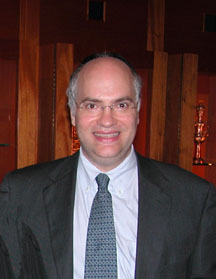


Contact info: Tel. 718-631-6071 or
Email: rscal@qcc.cuny.edu
Office Hrs. for Fall 2010
Monday, Tuesday, & Thursday: 1:00 to 2:00 P.M.
About Me
Professor Roland Scal has been teaching at Queensborough since 1999. He teaches courses in both geology and biology which reflect his interests in earth sciences systems and ecology of both the present and past.
Interests in geology include: gemstones and pearls, mineralogy, and sandstone depositional systems. Biological interests include: brachiopod and mollusc ecology past and present, marine coastal ecology, and the Eastern woodlands of the United States. In pursuit of these interests Professor Scal conducts laboratory research on gemstones, with a specific focus on pearls and mollusc shells, and field research and laboratory analysis of Paleozoic marine sandstones of the Appalachian Basin, terrestrial and marine sandstone mineralogical studies of the Devonian Catskill Sediments, and fossil collecting of these units and Cretaceous through Triassic units in New York and New Jersey and from the south coast of England.
At present Professor Scal is course coordinator for Physical Geology (GE 101) and is developing new curricula in both lecture and laboratory on the Study of earthquakes and Earth's interior in a collaboration with Mr. Dominick Naccarato, an Earth science teacher at Cardozo High School and Professor Hugh Rance. We were lucky to be 1 of 13 award recipients in the Seismographs for Schools Program for 2004 given by IRIS and received an AS1 seismograph (identical to the one on display in the Hall of Planet Earth at the American Museum of Natural History). We hope to have a website operating soon that will have live seismic data from our station. If properly placed, we have the possibility of recording earthquakes from around the world!
Gemology
Gems and Semiprecious Stones was taught for the first time in Fall 2005 and continues to grow. The course is offered every semester. This course will continue to be developed and focused so that students may gain a knowledge of the gem trade and New York City's vital role in it. Student projects are currently in development and at present we are studying cultured pearls available in the NYC jewelry market, using electron microscopy and X-ray analysis. Students and colleagues are always welcome to drop by with specimens for identification or to ask questions about geology, gems, rocks & minerals, and fossils.
Electron Microscopy
Something that may be of interest to students is that we just purchased a scanning electron microscope (click here to learn more) funded by the National Science Foundation. As well, we were just funded to purchase an X-ray microanalysis system and carbon coater and hope to get the instrument and begin working with students on projects on the new equipment in Late Fall 2008. I am looking for students to do projects on gem materials , while Principal Investigator David Sarno and Co-PI Moni Chauhan of Chemistry are working on nannotechnology and organic chemistry projects.
Gemstone Lecture Series
A series of lectures on gemstones and precious earth objects by accomplished scientists, industry experts, and gem professionals is planned for Fall 2007-Spring 2008. If you would like to be informed about these lectures, send a request to be added to our email list (all notices are sent Bcc. to maintain confidentiality).
Courses Taught
1. Gems and Semiprecious Stones (Ge 105) (3 credits, 3 class
hrs.) (go to Prof. Scal's class lecture notes)
2. Physical Geology (Ge 101) An Introduction to Geology (4 credits,
3 class hrs., 3 lab hrs.) (go to Prof. Scal's class lecture notes)
3. Historical Geology (Ge 102) An Introduction to Earth's History (4
credits, 3 class hrs., 3 lab hrs.) (Go to Prof.
Hugh Rance's website)
4. Biology 110 (BI 110) Fundamentals of Life Science(3 credit, 3
class hrs.) (Course
Description)
You can e-mail me by clicking on the ICON (photograph of the mineral tourmaline) below...